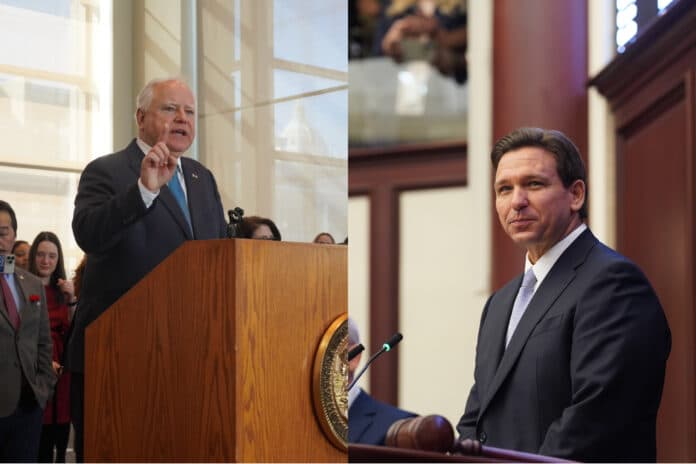
As Florida Gov. Ron DeSantis revs up his presidential run, Minnesota’s governor, Tim Walz, has been setting himself up as “the anti-DeSantis.”
In December, he told the Star Tribune: “I’m going to run ads in Florida for teachers … Come here! Yeah, it’s a little colder … But we’ll let you teach.” He was at it again this week, pushing the same culture war themes, holding up copies of “Lord of the Flies,” “Of Mice and Men,” and “The Handmaid’s Tale,” and proclaiming – falsely – that “These books are banned in the state of Florida. That’s where freedom goes to die.”
Walz might be entirely correct in describing himself as the yin to DeSantis’ yang. So shallow is the Democrats’ talent pool as they cast around for a replacement for the ailing President Biden that there are even the stirrings of a ‘Draft Walz’ movement.
The trouble is that Americans seem to prefer what Florida Gov. Ron DeSantis is selling.
Census Bureau data show that since the two men took office in January 2019, 43,531 Minnesotans have, on net, fled Walz’s Minnesota to live elsewhere in the United States. DeSantis’ Florida, by contrast, has attracted a staggering 853,720 residents from elsewhere in the United States (The ‘It’s the Weather’ crowd might like to note that both Wisconsin and South Dakota have seen net inflows over this period).
Even more galling for the ‘Draft Walz’ movement is that even Minnesotans seem to prefer what DeSantis has to offer. Internal Revenue Service data show where Americans have moved from and to. For 2019-2020 — the only year of their two tenures for which we have data so far — Walz’s Minnesota lost, on net, 3,921 residents to DeSantis’ Florida.
If Americans, and Minnesotans and Floridians specifically, prefer DeSantis’ government to Walz’s when they vote with their feet, they also seem to feel the same way when they vote with their vote.
DeSantis saw his vote share increase by 9.8 percentage points between the gubernatorial election of 2018 and that of 2022 while Walz saw his fall by 1.5 percentage points. If we look at the number of votes cast for each candidate, DeSantis saw an increase of 13.2% between the gubernatorial election of 2018 and that of 2022 while Walz saw a fall of 5.8% — that much vaunted “trifecta” rests on some rather shaky electoral foundations.
The fact that the election results, like the migration numbers, favor DeSantis over Walz ought not be surprising given the relative economic performance of DeSantis’ Florida and Walz’s Minnesota.
Between 2018 and 2021, Bureau of Economic Analysis data show that real Gross Domestic Product grew by 9.3% in DeSantis’ Florida compared to 2.8% in Walz’s Minnesota. Total employment rose in DeSantis’ Florida by 5.3% between 2018 to 2021 while it fell in Walz’s Minnesota by 2.2%.
A Walz vs. DeSantis contest in 2024 would offer a very clear choice between two governing philosophies. The migration and electoral numbers indicate how that might go. The economic numbers might tell you why.
















